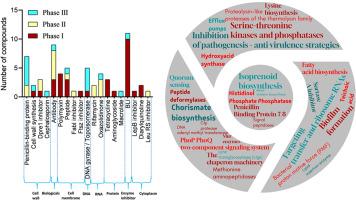Potential next generation targets for antibacterial agent’s discovery and development
IF 5.9
2区 医学
Q1 CHEMISTRY, MEDICINAL
引用次数: 0
Abstract
Inappropriate and excessive use of antimicrobials, in addition to evolutionary process, lead to the development of antimicrobial-resistant strains at an unprecedented accelerated rate, leading to global public health crisis. Antimicrobial resistantance is a global challenge that not only causes mortality and disability but also carries, affect all the countries regardless of wealth, health care infrastructure and socio-economic conditions leading to huge economic loss. Recent studies have indicated that we are moving back to the post-antibiotic era at a faster rate as our novel antibacterial armamentarium has almost reached zero. Unfortunately, lead molecules in the preclinical pipeline are unable to tackle drug-resistant bacteria as these are either derivative of clinically used antibiotics or against the target for which resistance development has already started. Currently, the need for development of new antimicrobials with novel mechanisms is pressing more than ever due to the impending global clinical crisis and no new antibacterial agent with novel target has been added in the last 10 years. Herein, we summarized 28 feasible unexplored targets for the development of novel antibacterial agents. As antimicrobial resistance is a universal problem, this review lists novel molecules that are reported to have antibacterial activity and their potential sites in the past five years so that researchers can start on building those scaffolds to develop safe, effective and affordable drugs. Furthermore, we provide an overview of the key gaps, issues and approaches that need to be revisited is presented. This review emphasis strategy that help in harmonization of procedures and also to reduce the attrition rate in the next generation antibacterial drug development process.

潜在的下一代抗菌剂的发现和开发目标
不适当和过度使用抗菌素,除了进化过程之外,导致抗菌素耐药菌株以前所未有的速度发展,导致全球公共卫生危机。抗微生物药物耐药性是一项全球性挑战,不仅导致死亡和残疾,而且影响到所有国家,无论其财富、卫生保健基础设施和社会经济条件如何,导致巨大的经济损失。最近的研究表明,我们正在以更快的速度回到后抗生素时代,因为我们的新型抗菌药库几乎为零。不幸的是,临床前管道中的铅分子无法解决耐药细菌,因为这些细菌要么是临床使用的抗生素的衍生物,要么是针对已经开始产生耐药性的靶标。目前,由于迫在眉睫的全球临床危机,开发具有新机制的新型抗菌药物的需求比以往任何时候都更加迫切,而在过去的10年里,没有新靶点的新型抗菌药物被添加进来。在此,我们总结了28个可行的尚未开发的新型抗菌药物靶点。由于抗菌素耐药性是一个普遍存在的问题,本文列出了过去五年来报道的具有抗菌活性的新分子及其潜在位点,以便研究人员可以开始构建这些支架,以开发安全、有效和负担得起的药物。此外,我们还概述了需要重新审视的关键差距、问题和方法。这篇综述强调了在下一代抗菌药物开发过程中有助于程序协调和减少损耗率的策略。
本文章由计算机程序翻译,如有差异,请以英文原文为准。
求助全文
约1分钟内获得全文
求助全文
来源期刊
CiteScore
11.70
自引率
9.00%
发文量
863
审稿时长
29 days
期刊介绍:
The European Journal of Medicinal Chemistry is a global journal that publishes studies on all aspects of medicinal chemistry. It provides a medium for publication of original papers and also welcomes critical review papers.
A typical paper would report on the organic synthesis, characterization and pharmacological evaluation of compounds. Other topics of interest are drug design, QSAR, molecular modeling, drug-receptor interactions, molecular aspects of drug metabolism, prodrug synthesis and drug targeting. The journal expects manuscripts to present the rational for a study, provide insight into the design of compounds or understanding of mechanism, or clarify the targets.

 求助内容:
求助内容: 应助结果提醒方式:
应助结果提醒方式:


